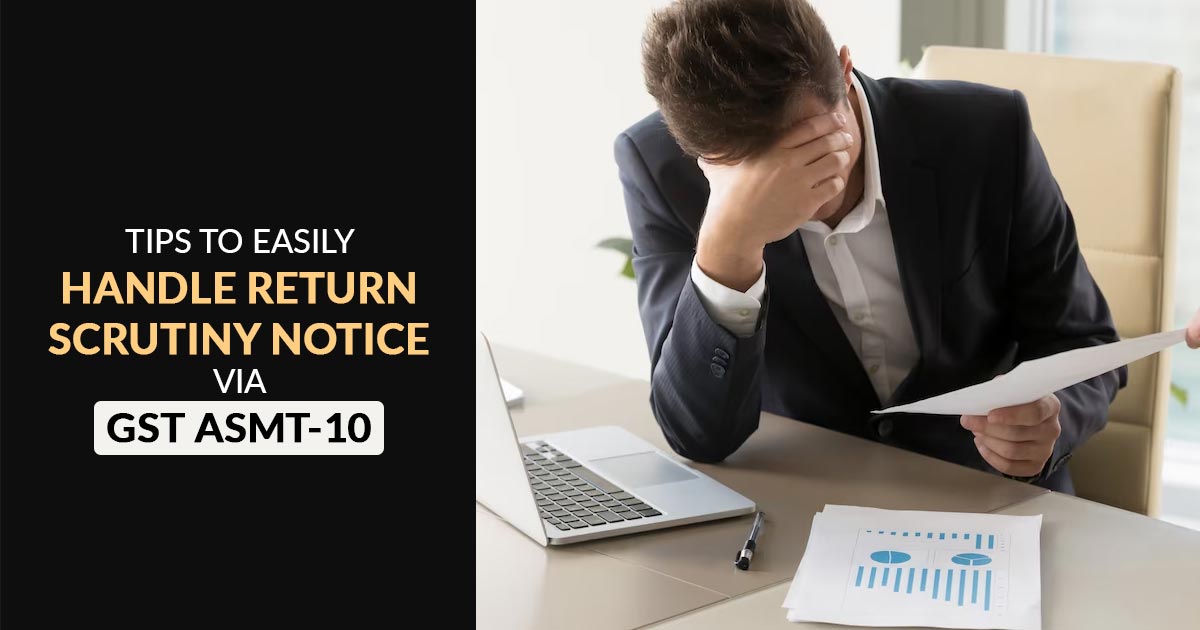
A person registered under GST would be needed to file the GST returns as per the norms of the GST law. But there might be some cases when you might obtain a GST return scrutiny notice in ASMT-10. It provides you with a notice which has been issued via the department for validating the preciseness and completeness of your GST returns.
What is GST Return Scrutiny?
The term “scrutiny” entails a thorough and critical examination or observation of various documents, papers, or other relevant materials. For example, in such electoral processes, scrutiny refers to the official review of votes in elections to identify and address any invalid votes, thereby ensuring the accuracy and validity of the reported results.
According to P. Ramanatha Aiyar’s definition in the Advanced Law Lexicon, “scrutiny assessment” pertains to in following terms:
“Scrutiny assessment- It arises where an assessing officer considers it necessary to ensure that the assessee has not (a) understated his income, (b) returned excessive loss or (c) underpaid the tax. He may serve a notice on the assessee requiring him to appear on the specified date or to furnish any documents/evidence in support of his return.”
Scrutiny Process for GST Returns and Tax Audit
Regarding scrutiny and auditing processes, the CGST Act of 2017 mandates audits under Sections 65 and 66, while GST return scrutiny is conducted under Section 61 of the CGST Act, 2017. The GST scrutiny process involves comparing, matching, and reconciling various numbers and tables. If return scrutiny reveals potential discrepancies, an audit may be requested. However, it is important to note that return scrutiny does not automatically lead to an audit. Additionally, return audits cannot be conducted for instances that have already undergone audit procedures.
No GST Return Then No Scrutiny U/S 61
To ensure compliance and accuracy, the filing of returns is subject to “scrutiny” as per the provisions of Section 61 of the CGST Act, 2017. This entails necessary scrutiny of the filed return. Consequently, if a taxpayer fails to file their return or is not registered with the tax authorities, the return cannot undergo scrutiny.
A return must be filed in order for it to be subject to scrutiny. The guiding principle of Section 61 of the CGST Act, 2017 is “No return, no scrutiny.”
The cases of non-filing of returns fall under the purview of Section 62 of the CGST Act, 2017, allowing the proper officer to make the best judgement assessment.
Furthermore, under Section 61, the proper officer is not authorised to issue a notice for the filing of a return.
Online Process of GST Return Scrutiny
Given that the entire GST system functions online, all aspects of return scrutiny, including selection, notice issuance, response, and payment, are carried out through online channels. Offline submissions, in some cases, must be uploaded onto the system under the designated “reference tab” by the Proper Officer.
Time Limit to Reply for GST Return Scrutiny
Regarding the timeframe for responding to a notice of discrepancy issued by the proper officer during the return scrutiny, the officer may grant an extended period, not exceeding 30 days from the date of notification, for the taxpayer to provide a reply.
Important Points to Manage GST ASMT-10 Scrutiny Notice
- Read and learn about the differences shown in the notice and as per that reply. The differences are provided para-wise hence the para-wise answer would be preferred.
- The differences that are been shown in the notice are related to the reconciliation issue or any data not furnished or furnished wrongly in the returns filed on the GST portal.
- If the disparity is related to an outward supply reconciliation issue, the cause for the difference should be determined, and the reconciliation in tabular form, together with the reason for the difference, should be supplied as a response to a such discrepancy. Furthermore, if just information concerning external supply is necessary, that information must be given.
- For the case, the discrepancy related to excess ITC claimed in GSTR-3B as against GSTR-2A. In that case, when the period of scrutiny of return concerned with the FY 2017-18 and FY 2018-19, in that case, please refer to Circular No. 183/15/2022-GST on December 27, 2022, which clearly articulates GSTR-2A is not pertinent to decide the ITC eligibility in FY 2017-18 and FY 2018-19 and the ITC is to be claimed on self-assessment grounds as per the fulfilment of other conditions i.e. Section 16, Section 17 and Section 18. Rule 36(4) may also be directed which came into force only w.e.f. October 9, 2019, and also refer to Section 16(2)(aa) of CGST Act, 2017, which also come into force w.e.f. January 1, 2022. While furnishing the answer to the articulated issue, given circular and provisions might be directed to.
- Assemble all of the supporting documentation in one location before sending your response. Additionally, you should include the most pertinent papers as an annexure to your reply and submit it on the GST portal.
- If you believe a personal hearing would be preferable to the officer in order to explain the cause of the disparities, please expressly note this in your reply and choose the hearing option on the GST portal.
- Following the submission of the response, follow up with the department to request the dismissal of the case or the issuance of the department’s order.
Managing the GST return scrutiny notice in ASMT-10 needs updated skills in the GST, proper preparation of answers, documentation, and cooperation with the GST department. Through such measures, you are enabled to ensure that the scrutiny procedure would get finished smoothly and without any problem.









